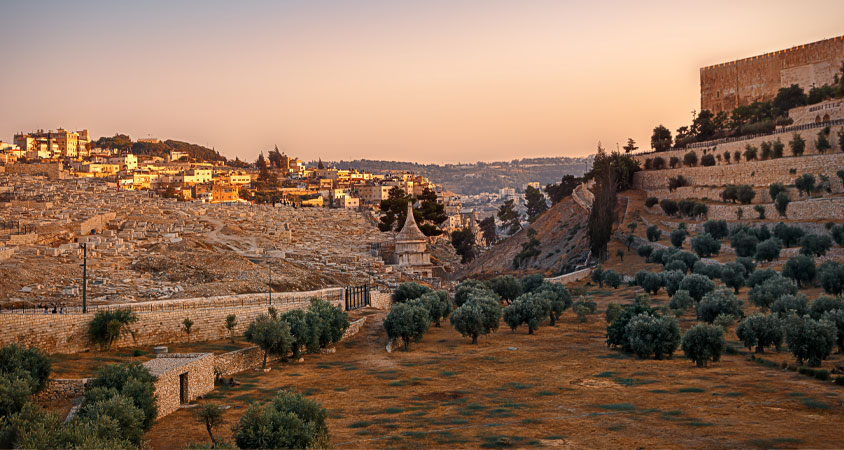Named for the abundance of olive groves that once flourished on its slopes, the Mount of Olives has a long and storied past. Also known as Mount Olivet, this mountain ridge to the east of Jerusalem’s Old City is one of the most widely recognized sites of significance within the Holy Land. From the time of the biblical kings, all the way through the life of Jesus as recorded in the Gospels, the Mount of Olives has played an important role in Israel’s history. Today, the Mount of Olives is a site of Christian pilgrimage for Catholics, Eastern Orthodox, and Protestants alike, with the hilltop now a Jerusalem neighborhood.
When you walk on the Mount of Olives where Jesus walked, and witness the panorama of the Old City, the Kidron Valley, and the Temple Mount ‘through’ Jesus’ eyes, the one word that comes to mind is ‘profound.’ Even more profound is the realization of fulfillment that the feet of Jesus will once again trod that same place when He returns (Zechariah 14:1-9).
OLD TESTAMENT SIGNIFICANCE
The Mount of Olives was first mentioned in connection with King David escaping the city from his son, Absalom, who was conspiring against him (2 Samuel 15:30). The Mount is also known for King Solomon’s use of its southern peak during the First Temple period. It was called the Mount of Corruption because Solomon’s Moabite and Ammonite wives used the location to worship their false idols (1st and 2nd Kings). It wasn’t until King Josiah that the Mount returned to its holy beginnings.
Also noteworthy is a prophecy written within the Book of Zechariah stating that the Mount of Olives will be the place of the Messiah’s return during the end times.
Following David’s conquest of the city in 10th century BC, many centuries-old, the Mount of Olives remains an active cemetery even today. There are many within the Jewish community who adhere to this belief and request to be buried on the Mount of Olives. There is an honor and prominence associated with being buried on the Mount of Olives.
NEW TESTAMENT SIGNIFICANCE
The Mount of Olives is frequently mentioned throughout the New Testament, especially in the Gospels of Matthew and Luke in reference to the life of Jesus. The teaching of the Lord’s Prayer, the weeping over Jerusalem (commemorated at Dominus Flevit), His prayer and arrest within the Garden of Gethsemane, as well as His Ascension into Heaven all occurred on, or near, the Mount. According to ancient tradition, Mary, the mother of Jesus, and Stephen, the first bishop of Jerusalem who was stoned to death, are believed to be buried here.
TOURING THE MOUNT OF OLIVES
When you’re visiting Jerusalem, the Mount of Olives is an ideal place to start your tour. Accessing the site is easy and affordable. Take a taxi or a bus to the top. From there you can walk down the Palm Sunday Road to the Garden of Gethsemane. If you’re feeling adventurous, continue your walk across the valley and up the hill toward Jerusalem to the Lion’s Gate (also called St. Stephen’s Gate). There you can enter the Old City near the beginning of the Via Dolorosa.
One of the most evocative features of the Mount of Olives is its cemetery. To date, there are over 150,000 gravesites and tombs located on, and around, the Mount of Olives, some of which include the Prophets Haggai, Zechariah, and Malachi.
This site of significance is the largest and perhaps the most prestigious cemetery of its kind.
The Mount of Olives also boasts an impressive number of churches in such a small area — more than six. This is a perfect beginning to your Mount of Olives experience. Some of the churches offer stunning panoramic views of Jerusalem and the surrounding area. Check out the magnificent Church of Ascension and then explore the Church of All Nations, located in the Garden of Gethsemane.
If you want to learn more about the Mount of Olives, the sites on the mount, or locate graves in the cemetery, there is an information center located near the Lion’s Gate.
Visiting Jerusalem? Start with the Mount of Olives on your next trip to Israel!
Email Cindy at cindy@israeladvantagetours.com or visit www.israeladvantagetours.com to make your trip of a lifetime a reality!















